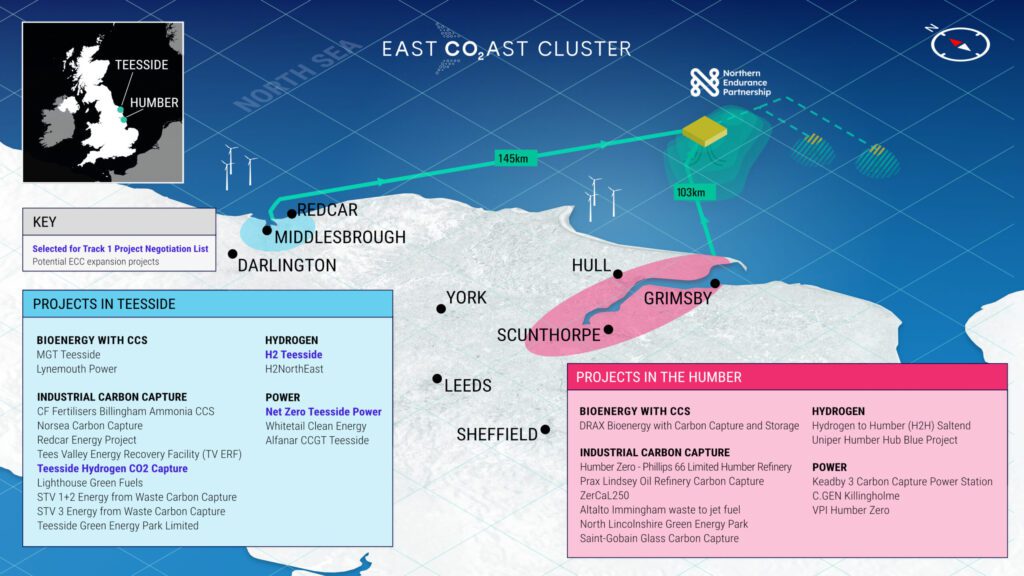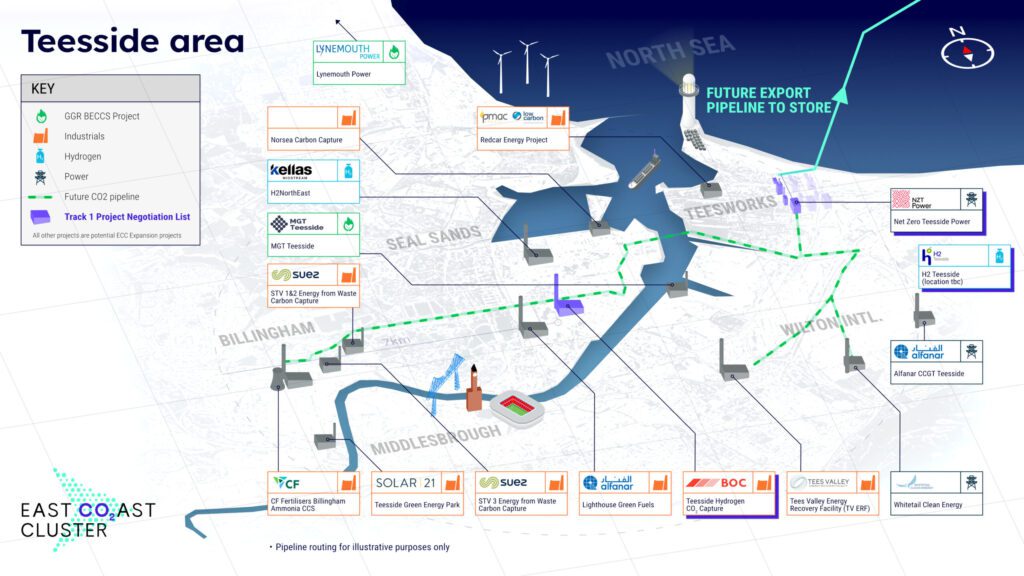UK Commercial Gas Power Project Equipped With Carbon Capture Unveils Contractors
Eight engineering, procurement, and construction contract packages have been unveiled for the UK’s Teesside-based Net Zero Teesside Power (NZT Power), a landmark integrated project that could become one of the world’s first commercial-scale gas-fired power stations equipped with carbon capture when it begins operation in 2027.
NZT Power, a joint venture between bp and Equinor, on March 15 said the proposed 860-MW gas-fired power plant will feature a GE Vernova 9HA.02 gas turbine, a steam turbine, a generator, and a heat recovery steam generator (HRSG). The combined cycle plant will fully integrate with a carbon capture plant that will use Techniqp Energies’ Canopy T.EN solution (powered by the Shell CANSOLV CO2 capture technology) to capture up to 2 million tonnes of CO2 per year.
The captured CO2 would then be compressed, transported via pipeline, and stored in the Endurance saline aquifer (about 145 kilometers away) in the North Sea by the Northern Endurance Partnership (NEP), a joint venture between BP, Equinor, and TotalEnergies.
NZT Power and NEP will form a key part of the East Coast Cluster (ECC) in Northeast England, a significant UK initiative aimed at decarbonizing the UK’s Humber and Teesside industrial regions. NEP’s Teesside onshore infrastructure is expected to specifically serve three Teesside-based carbon capture projects: NZT Power, H2Teesside, and Teesside Hydrogen CO2 Capture.

Key Contracts Unveiled
On Friday, NZT Power and NEP unveiled nine leading specialist contractors across eight packages. Final award of the contracts, however, will be “subject to the receipt of relevant regulatory clearances and positive Final Investment Decisions (FID) by the projects and UK government, planned for September 2024 or earlier.” Following the FID, NZT Power and NEP will target commercial operations from 2027, the companies said.
|
Contract Package |
Contractors |
|
Onshore Power, Capture and Compression |
Technip Energies and GE Vernova consortium including Balfour Beatty as the construction partner and Shell as the technology licensor |
|
Onshore CO2 gathering system and gas connection |
Costain |
|
Linepipe – Onshore and Offshore |
Marubeni-Itochu Tubulars Europe Plc with Liberty Steel Hartlepool, Corinth Pipeworks and Eisenbau Kramer GmbH as the nominated pipe-mills |
|
Offshore Pipeline, Landfalls, Onshore Outlet Facilities and Water Outfall |
Saipem |
|
Offshore Subsea Injection System |
TechnipFMC |
|
Power and Communications Cable |
Alcatel Submarine Networks |
|
Offshore Systems Engineering |
Genesis |
|
Integrated Project Management Team |
Wood |
A Win for a Major UK CCUS Cluster
Selection of the contractors on Friday is a major step forward for NZT Power and marks clear momentum within the ECC. The ECC, notably, has evolved into a major component of the UK government’s broader strategy to support the development of carbon capture, utilization, and storage (CCUS) technologies and hydrogen production as the country seeks to transition to a low-carbon economy.
While the UK currently has no commercial applications of CCUS, the government has a target to capture and store 20 million tons of CO2 (MtCO2) to 30 MtCO2 (including removal) per year by 2030, the London School of Economics and Political Science (LSE) notes.
Following two failed funding competitions in 2011 and 2015 to help commercialize carbon capture and storage (CCS) technology from power plants, the government in 2020 confirmed its support to deploy CCUS in four industrial clusters. In November 2021, it ultimately picked the North West (now HyNet) and ECC for initial support, anticipating these “Track 1” CCUS clusters could enter commercial operation in the mid-2020s. The government expects two other clusters may come online in the 2030s.
As part of the so-called “cluster sequencing” process, the UK Department for Energy Security and Net Zero (DESNZ) in March 2023 announced £20 billion to bolster its initial CCUS deployments and unveiled eight projects that would proceed to negotiations for support. In the ECC, these include NZT Power, bpH2Teesside, and Teesside Hydrogen CO2 Capture—the three projects Teesside onshore NEP infrastructure is designed to serve. “It is anticipated that around 4 million tonnes of CO2 per year from these projects would be transported and stored from 2027,” NEP said last week.

On Feb. 16, NZT Power also crucially garnered development consent by the UK Secretary of State for Energy Security and Net Zero. According to the UK government, NZT Power’s application involved “a full chain” CCUS project, comprising a CO2 gathering network, including CO2 pipeline connections from industrial facilities on Teesside to transport the captured CO2 (including the connections under the tidal River Tees); a CCGT electricity generating station with an abated capacity of up to 860 MW of low carbon electricity, cooling water, gas and electricity grid connections and CO2 capture; a CO2 gathering/booster station to receive the captured CO2 from the gathering network and CCGT generating station; and the onshore section of a CO2 transport pipeline for the onward transport of the captured CO2 to a suitable offshore geological storage site in the North Sea.
Forging a Gas-Fired Carbon Capture Model for Commercial Power
As GE Vernova and Technip noted in a statement on Friday, if built, the proposed NZT Power project will model a crucial effort to establish commercial gas power with carbon capture.
“The development of Net Zero Teesside Power, one of the world’s first commercial-scale gas-fired power stations with carbon capture, marks a huge step towards supporting the UK government’s commitment to fully decarbonize its power system by 2035,” said Maví Zingoni, CEO of GE Vernova’s Power business in a statement. “GE Vernova will help bring proven expertise in natural gas combined cycle plant engineering, operability, and full-scale integration to support carbon abatement for this project,” she said. “We believe post-combustion carbon capture can play a crucial role in reducing emissions and ensuring dispatchable power in the future.”
Technip CEO Arnaud Pieton agreed. “By capturing up to 2 million tonnes of CO2 at a large power plant, we collectively rise to the challenge of scale by providing sustainable and available energy at a large scale,” he said.
GE Vernova and Technip are partnering with international infrastructure group Balfour Beatty. The three companies, along with Shell, which will provide the capture technology, recently formed the Carbon Capture Alliance (CCA). “The alliance members are deeply committed to long-term investment in the UK, with members already possessing a significant UK footprint and a mature UK supply chain,” the companies said.
—Sonal Patel is a POWER senior associate editor (@sonalcpatel, @POWERmagazine).